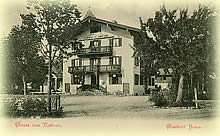Chronicle
History Rottach-EgernThe community Rottach-Egern previously mentioned for the first time with Adalprecht de Rota, both belonged to the monastery Tegernsee, founded 746 under Abbot Eberhardt. Rottach-Egern was a fishing and farming village and received its impetus mainly by the Benedictine monastery Tegernsee, which existed until the secularization in 1803 and was famous for its library. |
|
|

|
Chronicle guesthouse PfatischerToday's guest house was built in 1902 and led as Gasthof Hahn. 1906 acquired Johann and Elise Pfatischer buy over and run the guesthouse with its own butcher shop, beer garden and rooms for rent in Bavarian style. Ludwig Pfatischer the trained butcher and his wife Katharina took over the family business very early. First, the Fremdenheim Pfatischer was a rest home of the mining workers and Kurheim for the german company Siemens to increasingly tourism gained importance. The house was repeatedly upgraded or expanded, modernized and extended. 1967 rendered Ludwig and Katherina Pfatischer pioneering work on the construction of the first indoor swimming pool far beyond the counrty area. 1990 was followed by the expansion of the spa area with sauna, steam bath, fitness, through the Son Bernd Pfatischer. Since 1999, now sets Bernd and Rosi Pfatischer with Christina and Tobias the long-standing family tradition. The end of 2010, the new building of the holiday home “Landhaus” was finished in rustic style in the garden. There are guests apartments of various sizes available. 2025 we stopped renting out the guesthouse and closed permanently. However in the country house the apartments will remain available. Your |




